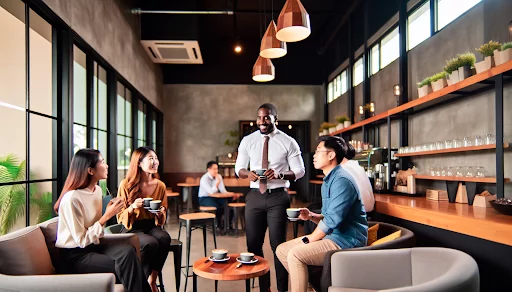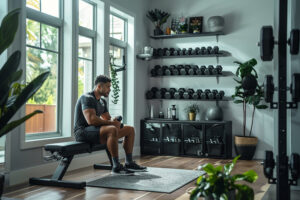How I Built a $6M Coffee Empire Starting from My Garage
Seattle’s coffee landscape transformed forever when two ambitious audio engineers turned their garage into a coffee roasting operation. Their innovative approach to cold brew coffee and commitment to quality has now blossomed into a $6 million empire that continues to redefine the specialty coffee industry.
We strongly recommend that you check out our guide on how to take advantage of AI in today’s passive income economy.
Table of Contents
The Journey Begins: From Audio Engineers to Coffee Entrepreneurs
Working as audio engineers touring with bands across the globe provided an unexpected foundation for entering the coffee business. Each morning began with the crucial quest for quality coffee, highlighting a universal need that would later inspire a groundbreaking business venture.
During those touring years, coffee became more than just a daily necessity – it evolved into a passion project. The transition from sound mixing to coffee brewing wasn’t as dramatic as it might seem, as both require an acute attention to detail and a deep understanding of process control.
Starting Small: The Garage Startup Story
Innovation often begins in humble settings, and this story is no different. Converting half of a residential garage into a commercial kitchen marked the first step toward building what would become a coffee empire. The other half remained a traditional garage, creating an unlikely but effective dual-purpose space.
The city’s approval came with an interesting caveat – roasting could continue as long as neighbors didn’t complain about the smell. This led to nighttime roasting sessions, perfectly aligning with their late-night audio engineering schedules. The aroma of roasting coffee, often mistaken for burning popcorn, would waft through the neighborhood under cover of darkness.
Breaking Into the Market: The Cold Brew Revolution
Becoming Seattle’s first company to bottle cold brew coffee opened doors that seemed impossible to access otherwise. Within just eighteen months, their product reached 300 grocery locations, all while operating from that converted garage space. This rapid expansion demonstrated the market’s hunger for innovation in the coffee industry.
A tiny 2.5 kilo roaster served as the foundation of their operation. The limited capacity meant multiple roasting sessions were necessary to meet growing demand, but this constraint ensured consistent quality control during the crucial early stages.
Scaling Up: From Garage to Commercial Success
The transition from garage operation to commercial warehouse space marked a pivotal moment in the company’s growth. Investment funding provided the necessary capital to expand operations and secure larger grocery accounts, though this growth came with its own set of challenges and learning experiences.
Their first retail location generated $2,100 on opening day, with an ambitious goal of reaching $2,700 daily to achieve million-dollar annual revenue. Despite initial fluctuations, the location exceeded expectations, reaching $810,000 in its first year and climbing to $1.2 million in the second year.
Building the Brand: Marketing and Customer Engagement
Rather than relying on traditional marketing methods, the business grew through grassroots efforts and word-of-mouth marketing. Simple strategies like distributing free drink cards to hotel concierges and local businesses proved more effective than expensive PR campaigns.
The company’s decision to invest $21,000 in a PR firm proved less valuable than their organic marketing efforts. This experience reinforced the importance of authentic connection with customers over manufactured publicity.
Vertical Integration: The Bakery Evolution
Expanding into in-house bakery operations demonstrated the power of vertical integration. Beginning with simple offerings like scones and cookies, the bakery division grew to supply all locations, improving profit margins and quality control while reducing reliance on external suppliers.
Financial Insights and Business Strategy
The business currently operates three retail locations plus a roastery, each generating between $800,000 to $1.7 million annually. While industry standard profit margins range from 2.5% to 6.8%, maintaining a 5% profit margin requires careful attention to costs and operational efficiency.
Initial startup costs for their first location totaled $500,000, split between buildout costs ($350,000), equipment ($100,000), and operating capital ($50,000). Creative financing through private investors and secured loans made this possible despite lacking traditional business history.
Lessons Learned and Future Growth
Location selection proves crucial for success in the coffee industry. Population density, foot traffic patterns, and understanding local coffee consumption habits all play vital roles in store performance. The company’s experience with both successful and struggling locations highlights the importance of thorough market research.
Key Success Factors
Quality control remains paramount, from sourcing the highest quality coffee beans to maintaining consistent roasting profiles through advanced equipment like color sorters. This commitment to excellence led to winning America’s Best Espresso award, establishing credibility within the specialty coffee community.
The journey from garage startup to $6 million coffee empire demonstrates that success in the specialty coffee industry requires more than just passion – it demands innovation, persistence, and the willingness to learn from both successes and failures. This story serves as inspiration for aspiring entrepreneurs in any industry, proving that with the right combination of timing, quality, and determination, substantial growth is possible even in highly competitive markets.

We strongly recommend that you check out our guide on how to take advantage of AI in today’s passive income economy.




